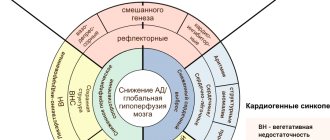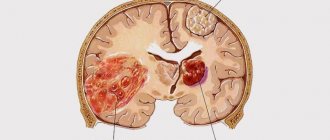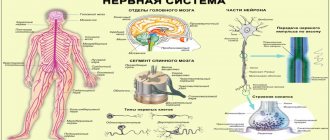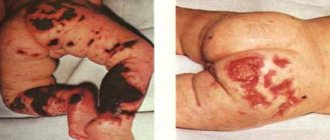About the disease
Right-sided hemiparesis is a pathology that is a right-sided lesion of the muscles of the body.
It is characterized by a noticeable decrease in strength and general motor ability of muscles, and incomplete paralysis of the limbs is possible.
This condition manifests itself due to acquired or congenital pathological changes in the pyramidal tracts and the brain.
Doctors observe deviations from the norm when a lesion appears in the left hemisphere of the brain.
This disease leads to the following consequences for the patient:
- Mobility and the patient’s ability to move independently, as well as to care for themselves independently, are reduced when hemiparesis occurs on the dominant side (right-sided hemiparesis in right-handed people);
- The patient experiences inflammatory changes that are associated with prolonged skeletal muscle cramps . This consequence occurs after serious disorders - intracerebral hemorrhages and strokes;
- A problem arises when trying to follow instructions for physical therapy when the patient is undergoing motor recovery due to limited mobility. This happens when there is spastic increased muscle tone.
In children
In children, this pathology occurs as a congenital disease . The reasons for its occurrence are abnormal functionality and structure of the brain , as well as birth injuries. In medical terminology, this disorder is called cerebral palsy - cerebral palsy.
Cerebral palsy appears due to a circulatory disorder in the brain. This pathology affects the fetus while still in the womb and leads to erroneous development and damage to brain structures.
Right spastic hemiparesis
Spastic hemiparesis, often called central, occurs when there is inflammation of the brain or cervical spinal cord.
With this disease, stiffness and muscle tension are observed in the limbs of the opposite side of the body. If individual nerves of the spinal cord are subject to inflammation, then hemiparesis is combined with weakness and decreased muscle tone.
This pathology does not immediately become noticeable; it manifests itself over several months. First, muscle tone increases, which creates tension in the arm and leg, a feeling of stiffness arises, and the ability of the limbs to move decreases. Then, if no treatment is followed, muscle tone continues to increase.
Important! An increase in muscle tone indicates damage to parts of the central nervous system - the brain and spinal cord.
Disturbances in movements that are accompanied by spasticity are seen by others from the outside based on distinctive signs - people have difficulties in gait, it acquires special features. Doctors call it Wernicke-Mann gait . This indicates diseases suffered by the brain - stroke and traumatic brain injury.
Symptoms of right-sided spastic hemiparesis are varied. These include speech disorders, fever, cognitive impairment and seizures similar to epileptic seizures.
Increased muscle tone indicates that the brain and spinal cord are damaged. To reduce tone, the doctor prescribes drugs that relax the muscles. The period of admission is usually long - up to six months, but sometimes longer.
What are hemiparesis and hemiplegia? Differences
Greetings, dear readers and guests of my blog insultu-net.ru, dedicated to neurorehabilitation. Today we will talk about one of the most common and persistent consequences of injuries and diseases of the brain and spinal cord, among which stroke and its consequences are one of its most common causes. Let's talk about hemiparesis and hemiplegia - what they are and what are the reasons for their occurrence. About what needs to be done to restore lost strength and regain movement in the limbs.
Wernicke-Mann gait in hemiparesis and hemiplegia
Hemiparesis is a decrease in muscle strength in half the body , without its complete loss.
Hemiplegia is a complete lack of strength in half the body , that is, paralysis.
Disease by severity
Doctors determine the severity of various types of paresis on a six-point scale:
- 0 points – complete absence of movement;
- 1 point – minor muscle movements are observed, the joints are not involved;
- 2 points – movement is possible, but in a vertical position, if there is no external resistance. The joints move barely noticeably;
- 3 points – muscles cope with gravity. Joint movements are constrained;
- 4 points – the patient makes movements, while losing a little strength in the muscles;
- 5 points – the patient makes movements without losing muscle strength.
Causes
The reasons for the development of hemiparesis vary depending on the age at which it develops, the conditions in which the patient was before the symptoms of the pathology appeared, etc.
In children
In children, hemiparesis occurs after various anomalies of the spine or limbs , damage to the brain structure, as well as various types of injuries to the skull or spine.
Hemiparesis also appears as a consequence of pinched nerve endings in the spine , atrophy of peripheral nerves and when the functioning of the brain is impaired.
Reference! Congenital hemiparesis usually develops due to abnormalities in brain development, fetal hypoxia, or trauma that the child receives while still in the womb - cerebral palsy.
In adults
The incidence of right-sided hemiparesis in adults is higher than in children . Most often this is a consequence of injuries or diseases of the left side of the brain.
The causes of hemiparesis in adults are more varied than in children:
- Stroke, as well as the formation of a tumor in the brain after a stroke;
- Traumatic brain injury;
- Encephalitis;
- Postepileptic state;
- Hemiplegic migraine;
- Diabetes mellitus and the disorders it causes;
- Multiple sclerosis;
- Atrophic cortical processes.
Right-sided and left-sided hemiparesis
In neurological practice, there is a connection between the clinical picture in the part of the body and the cerebral hemisphere in which the pathological focus arose. And this connection is reverse.
If weakness occurs in the right arm and leg, then this is a right-sided hemiparesis , if on the left, then is a left-sided hemiparesis . This is called contralateral hemiparesis.
Moreover, each hemisphere is responsible for its own specific set of certain body functions. Below is a picture that clearly shows the nature of the main functions of the cerebral hemispheres.
Functions of the hemispheres depending on the side
This scheme relates to higher mental functions; as for movements and sensitivity depending on the side of the hemisphere, the division is as follows: the right hemisphere is responsible for the movements of the left limbs, and the right hemisphere is responsible for the left ones.
What is typical is that if, as a result of a stroke or injury, the consequence is right-sided hemiparesis or hemiplegia, then it is often accompanied by severe speech impairments.
Right-sided hemiparesis is one of the most common manifestations of ischemic stroke, because it is in the left middle cerebral artery that circulatory disorders most often occur, which can cause lasting consequences in the form of sensory and motor impairments.
If left-sided hemiparesis occurs, then it may be accompanied by mental disorders, because the right hemisphere contains the majority of the nerve centers responsible for higher mental functions of a person. Left-sided hemiparesis is somewhat less common than right-sided hemiparesis.
After a stroke
If after a stroke the entire right side is completely paralyzed, this indicates that a large part of the left hemisphere was affected. Such a stroke has a pronounced clinical picture.
Firstly, these are speech and language deviations. This sign is the first and strongest indicator of a stroke. The patient has slurred pronunciation of words, impaired articulation, and the patient ceases to understand the speech of other people.
Secondly, the patient experiences a loss of speech and verbal memory, he has difficulty writing and reading, and forgets the necessary words and speech patterns.
Thirdly, a clear sign is paralysis of the right side of the body: face, arms, legs.
Fourthly, the patient experiences involuntary and reflex movements of the paralyzed limbs.
Diagnostics
When diagnosing right-sided hemiparesis, the doctor is obliged to collect complaints, anamnesis, a full examination of the patient, as well as research using special instruments. Their nature and duration depend on the form of the pathology.
When the cause of hemiparesis is discovered, the doctor performs a computer or magnetic resonance imaging, electromyography, and Doppler ultrasound of the blood vessels of the brain on the patient.
Reference! Children are diagnosed at the age of one to one and a half years, when they develop movement skills and motor disorders become more noticeable.
What should be the result after massage and exercise therapy for hemiparesis?
Of course, these methods are not a panacea. The benefits of massage with gymnastics in the prevention of contractures, the consequences of congestion, atrophy, training and maintaining muscles, nerves, blood vessels, bones and ligaments. After all, without stress, muscles weaken, ligaments become thinner, bones become thinner and more fragile. The functions of the musculoskeletal system must be preserved at least until the child grows to an age when he will more consciously work with a physical therapy instructor and perform increasingly complex exercises that will form the skills necessary for life.
Treatment
Treatment of hemiparesis in the first year after the onset of neurological disorders is fruitful.
In children
The complex for children with hemiparesis consists of the following components:
- Passive exercises for the affected limb. They are performed with the help of an instructor;
- Vigorous exercises performed with the help of a healthy limb and an instructor;
- Exercises that are aimed at improving coordination in the movements of the affected limbs;
- Reducing hypertonicity and movement that are intended to help;
- Walking;
- Breathing exercises;
- Development of fine motor skills;
- Relaxing massage;
- Swimming;
- Physiotherapy;
- Drug treatment.
In adults
The main thing is to approach the treatment of hemiparesis systemically. The doctor determines the severity and, depending on it, prescribes treatment. Typically it consists of the following points:
- exercise therapy;
- Swimming;
- Massage;
- Physiotherapy;
- Drug treatment.
Treatment of spastic hemiparesis in children
Therapeutic measures will be somewhat different in the early recovery period, late, and in the period of residual effects. The greatest intensity of treatment is in the first 2-3 years, hence the prognosis for future prospects. Many sources repeat that the earlier treatment is started, the greater the results. Of course this is true, but no less important is the correctly selected treatment methods and the quality of their implementation. You also need to understand that hemiparesis is not completely cured; it is only possible to partially restore lost functions. For most people, the diagnosis of cerebral palsy sounds scary, like a death sentence, in part this may be so, but I recommend that parents do not waste time and energy on despondency, but focus on the quality and regularity of treatment. Treatment of spastic hemiparesis in children is a long and expensive matter. The rehabilitation process is complex, usually in the first stages it is carried out in neurological hospitals, but after discharge it continues at home as prescribed by a doctor. Treatment is medicinal, massage, exercise therapy, physiotherapy, after 1.5-2 years speech therapists, psychologists, speech pathologists, orthopedic solutions are added.






